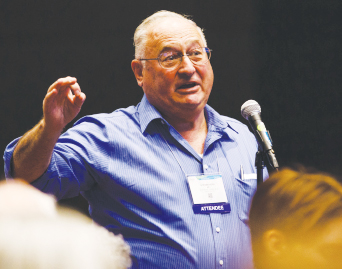Partial-breast irradiation delivered over 5 to 10 days did not meet noninferiority criteria compared with whole-breast irradiation given over 5 to 7 weeks, according to 10-year results of the large NRG (NSABP B-39/RTOG 0413) trial presented at the 2018 San Antonio Breast Cancer Symposium.1 However, the absolute 10-year cumulative difference in invasive breast tumor recurrence between the two treated groups was less than 1%, and the absolute cumulative difference in the relapse-free interval was 1.6%.

These small differences between treatments do not rule out a role for partial-breast irradiation for women after undergoing breast-conserving surgery.— Frank A. Vicini, MD
Tweet this quote
Experts suggest that these results should not rule out adoption of partial-breast irradiation for patients with early-stage breast cancer who want to undergo breast-conserving surgery and desire a shortened radiotherapy option as per the 2016 American Society for Radiation Oncology (ASTRO) Guidelines.2
“Breast cancer is now increasingly diagnosed at early stages due to advances in screening and public awareness, and more than 100,000 women in the United States face treatment decisions about breast-conserving surgery. These small differences between treatments do not rule out a role for partial-breast irradiation for women after undergoing breast-conserving surgery,” said lead author Frank A. Vicini, MD, principal investigator and radiation oncologist at the MHP Radiation Oncology Institute/21st Century Oncology in Pontiac, Michigan.
“For patients, the most important endpoints are disease-free interval and disease-free survival, and recurrences matter. This is the largest trial to compare these techniques, and the differences in the recurrence-free interval and recurrences between the two arms (although statistically different) are small.” Dr. Vicini continued. “We need to consider that survival is the same with partial-breast and whole-breast irradiation, and there is a dramatic difference in treatment duration of 3 to 7 weeks down to 5 to 10 days. Quality of life is potentially better with partial-breast irradiation. My bias is that with modern radiation techniques, there would be even less of a difference in invasive breast tumor recurrence and relapse-free interval between the two arms.”
Study Details
The NRG study enrolled 4,216 patients with ductal carcinoma in situ (DCIS), or stage I or II invasive breast cancer with 0 or 1 to 3 positive lymph nodes. Patients were randomly assigned to receive partial-breast irradiation prior to adjuvant chemotherapy (twice daily treatment with 3.4 to 3.85 Gy, totaling 10 treatments delivered over 5 to 10 days using 3-dimensional [3D] conformal external-beam radiation or brachytherapy) or whole-breast irradiation after adjuvant chemotherapy (twice daily treatment with 2 Gy of radiation, to a total of 50 Gy with a sequential boost to the surgical site given over 5 to 7 weeks).
The study enrolled both pre- and postmenopausal women with hormone receptor–positive or –negative tumors. Patients underwent lumpectomy, had histologically clear margins (ie, “no ink on the margin”), and no more than three positive lymph nodes. Patients were stratified prior to randomization for disease stage, menopausal status, hormone receptor status, and intent to receive chemotherapy.
The primary endpoint was invasive breast tumor recurrence (both DCIS and invasive cancer as a first recurrence). Secondary endpoints included distant disease–free interval, recurrence-free interval, and overall survival.
Baseline characteristics were comparable between the two study arms. At baseline, median age was 54 years, 61% were postmenopausal, 25% had DCIS, 65% had invasive node-negative breast cancer, and 10% had positive lymph nodes. Systemic chemotherapy was used in 27%, and adjuvant hormonal therapy was used in about 83%.
Key Findings
There were 161 invasive breast tumor recurrences as first events: 90 in the partial-breast irradiation–treated group vs 71 in the whole-breast irradiation–treated group. This result did not meet the upper limit of the hazard ratio for noninferiority, but the absolute difference between the two groups (4.6% in the partial-breast irradiation group vs 3.9% in the whole-breast irradiation group) was 0.7% and not significantly different.
Of the 71 recurrences in the whole-breast irradiation arm, 46 were at the site of the primary tumor and 25 occurred elsewhere in the breast. Women in the partial-breast irradiation arm had 39 recurrences at the primary tumor site and 51 recurrences elsewhere in the breast.
“As anticipated, patients receiving partial-breast irradiation had more recurrences outside the tumor bed region,” Dr. Vicini said.
The 10-year cumulative rate of relapse-free interval was 91.4% with partial-breast irradiation vs 93.4% with whole-breast irradiation (P = .02)—an absolute difference of 1.6%, which significantly favored whole-breast irradiation (P = .02). The 10-year rate of distant disease–free survival was 96.7% for partial-breast irradiation vs 97.1% for whole-breast irradiation, a difference that was not statistically significant. Overall survival at 10 years was 90.6% for partial-breast irradiation and 91.3% for whole-breast irradiation—again, not a significant difference.
RADIOTHERAPY IN EARLY BREAST CANCER
- The 10-year follow-up of the large randomized NRG (NSABP B-39/RTOG 0413) trial did not show noninferiority of partial-breast irradiation compared with whole-breast irradiation in patients with low-risk early breast cancer.
- The absolute differences in recurrence and events between the two techniques were small.
- Partial-breast irradiation may be offered to low-risk patients according to the ASTRO guidelines.
In the partial-breast irradiation arm, 71% of patients had 3D conformal external-beam radiation. Dr. Vicini said results suggest that if you just looked at patients treated with the 3D technique, partial-breast irradiation was comparable to whole-breast irradiation. “But the study was not designed to compare the three techniques, so we cannot make a definitive conclusion about the partial-breast irradiation method,” he said.
The rates of grades 3 to 5 toxicities were slightly higher in the partial-breast irradiation arm but not significantly different. This was true for radiation-induced second cancers as well. In light of the worse cosmesis reported in the RAPID trial studying the same question, a discussion of potentially increased cosmetic risk with 3D conformal accelerated partial-breast irradiation is warranted during the consent process.
Further Considerations
Speaking from the audience after the presentation, Steven E. Vogl, MD, a medical oncologist at Montefiore Medical Center, Bronx, New York, said: “You have convinced me that partial-breast irradiation is not much worse than whole-breast irradiation in terms of local control, local recurrence, and distant metastases. But without hearing long-term subjective patient-reported outcomes and cosmetic results, I don’t know what to tell my patients. You have to keep in mind that 97% of these patients will be free of distant

Steven E. Vogl, MD, of Montefiore Medical Center, Bronx, New York, asks a question following presentation of the NSABP B-39/RTOG 0413 study. Photo by © SABCS/Scott Morgan 2018.
metastases at 10 years. Achieving a better cosmetic outcome and less breast pain and deformity, among those survivors doing well, is the whole point!”
Dr. Vicini replied, “Data on quality of life and cosmesis will be forthcoming. Stay tuned. In the future, we will look at quality of radiation—that is, how much of the breast was treated. That is an important issue.”
During the discussion following the presentation, Dr. Vicini told listeners that he and his colleagues tend to offer partial-breast irradiation particularly to elderly patients and those who have transportation issues, among other candidates for whom the ASTRO guidelines apply. “This trial is over 15 years old, and radiation techniques have been refined. In the largest trial ever to explore partial-breast irradiation, the differences are small with extended follow-up. At present, I would advise offering partial-breast irradiation within the ASTRO guidelines.” ■
DISCLOSURE: The study was funded by the National Cancer Institute. Dr. Vicini is a research advisor for ImpediMed. Dr. Vogl reported no conflicts of interest.
REFERENCES
1. Vicini F, Cecchini R, White J, et al: Primary results of NSABP B-39/RTOG 0413 (NRG Oncology): A randomized phase III study of conventional whole breast irradiation versus partial breast irradiation for women with stage 0, I, or II breast cancer. 2018 San Antonio Breast Cancer Symposium. Abstract GS4-04. Presented December 6, 2018.
2. Correa C, Harris EE, Leonardia MC, et al: Accelerated partial breast irradiation: Executive summary for the update of an ASTRO evidence-based consensus statement. Pract Radiat Oncol 7:73-79, 2017.


